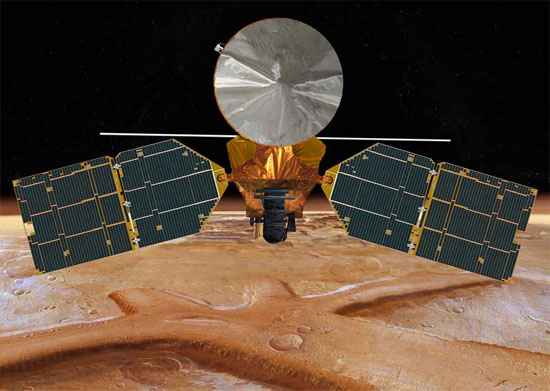Mars research paused in April because of the sun
Looking ahead in April, NASA's Mars discovery team will have some 'mandatory' holidays in about 17 to 21 days.
The reason is not because of budget cuts, but because the Mars will be in a position to interact with the Sun, then contact with the probe will be difficult to implement, even impossible. During this time, the mission control department will limit the operation of unmanned spacecraft to probe Mars and will not send any new command signals.
In April, Mars and Earth will be on opposite sides across the Sun. Because of the different rotational speeds of the two planets, this phenomenon will occur every 26 months and why Mars is close to the Sun's strong emission position, it may disrupt communication with the ships. probe around Mars or working on the surface of the red planet. This phenomenon will become apparent this year when Mars will fly over the Sun disk at an angle of only 0.4 degrees on April 17, 2013.

Mars Reconnaissance Orbiter (MRO)
In addition, this is the peak time of solar activity in a 22-year cycle. Although the Sun will not be too disturbing compared to normal, its operation is sufficient to erase or interfere with communication signals. This phenomenon not only caused the data transmission from spacecraft to Earth to be interrupted and needed to be sent back later, but also affected the signals sent from Earth, which could damage the probe. To limit the impact, the mission control department at the Jet Propulsion Laboratory in Pasadena, California will focus on jobs on Earth and will have a break.
Data transmission to the Mars Reconnaissance Orbiter (MRO) and Mars Odyssey trains will be interrupted from April 9 to April 26, 2013. Although the Odyssey will still continue to observe and send signals to Earth during this time, however, the engineers expected to have data of the Odyssey will still need to be resubmitted later. Meanwhile, the MRO will only operate in recording mode and receive about 60 gigabits of data from its devices plus 12 gigabit uploads from the Curiosity self-propelled vessel operating on Mars's surface. During the intersection, the Curiosity will still try to keep in touch with the Earth control department and update its status. At the same time on the surface of Mars, the Mars Exploration Rover Opportunity probe will continue its scheduled work.
The European Space Agency's (ESA) Mars Mars exploration ship will also be affected by the phenomenon of Mars-to-Sun interactions , but currently the ESA has not made any announcements.
- 4 Mars exploration equipment
- Start selling 'one-way tickets to Mars'
- Latest Mars map
- NASA suddenly announced shock about life on Mars
- Astronaut explores 'Mars' on ... Earth
- Did the ocean on Mars get into the rock?
- City projects on Mars are about to be built
- Recreate Mars model on Earth
- Is water still below the surface of Mars?
- Scientists have created
- Simulate life on Mars
- Discover more evidence of life on Mars
 Van Allen's belt and evidence that the Apollo 11 mission to the Moon was myth
Van Allen's belt and evidence that the Apollo 11 mission to the Moon was myth The levels of civilization in the universe (Kardashev scale)
The levels of civilization in the universe (Kardashev scale) Today Mars, the sun and the Earth are aligned
Today Mars, the sun and the Earth are aligned The Amazon owner announced a secret plan to build a space base for thousands of people
The Amazon owner announced a secret plan to build a space base for thousands of people